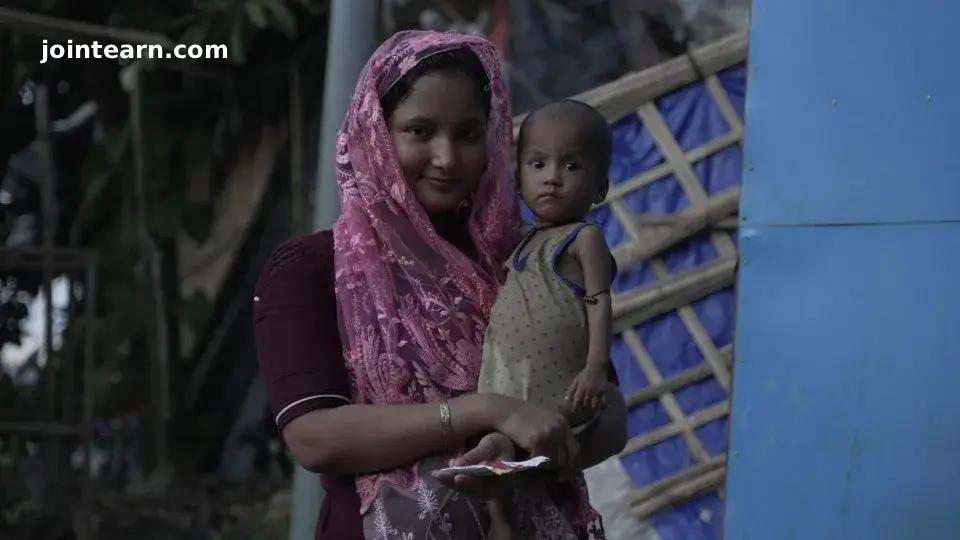
Cox’s Bazar, Bangladesh — In a sweltering refugee camp on Bangladesh’s southeastern coast, Fatima Begum kneels on the dirt floor of her bamboo hut, gently rubbing a peanut-based paste onto her malnourished daughter’s gums. The food packet, marked with the familiar USAID logo, once symbolized American generosity. Today, it represents what remains of a shrinking lifeline.
The United States’ $8 billion annual aid cuts, announced after the dismantling of USAID earlier this year under the Trump administration, have left a gaping void in humanitarian support — and children like Sofiya, Begum’s one-year-old daughter, are paying the price.
A Crisis Deepens in the World’s Largest Refugee Camp
Cox’s Bazar, home to over 1.2 million Rohingya refugees, has seen a sharp 11% rise in acute child malnutrition since January, according to UNICEF. Supplies of ready-to-use therapeutic food (RUTF) — a calorie-dense paste that has saved millions of starving children — are now being rationed.
“Before, they gave more food, but now they don’t,” Begum said softly. “They don’t give fruits like before. They don’t give fish. Still, I’m thankful for whatever they give.”
The Rohingya, a persecuted Muslim minority, fled Myanmar’s Rakhine State in 2017 following what the UN and US call a genocide. For many, Bangladesh offered safety — but now, the humanitarian lifeline is slipping away.
The Ripple Effect of US Aid Cuts
The Trump administration’s move to consolidate and reduce foreign aid — defended by Secretary of State Marco Rubio as an effort to “cut bureaucracy” and “prioritize national interests” — has triggered a domino effect across the global humanitarian system.
The results are devastating. A Lancet study projects the cuts could lead to 14 million deaths worldwide in the next five years. A real-time tracker from Boston University estimates 88 deaths every hour linked to aid shortfalls.
Even as Washington insists that emergency funding continues — citing a recent $60 million package for Rohingya refugees — aid groups on the ground warn that resources are evaporating.
“Cox’s Bazar is ground zero for the impact of budget cuts on people in desperate need,” said UN Secretary-General António Guterres during a visit in March. “People will suffer, and people will die.”
Lives on the Line: Shrinking Food and Medical Aid
In Cox’s Bazar’s Camp 15, workers from Concern Worldwide and UNICEF measure babies’ arms with color-coded bands to assess malnutrition. Red means severe — and more and more bands are turning red.
“More children are being detected with the severest form of malnutrition,” said Deepika Sharma, UNICEF’s Chief of Nutrition and Child Development in Bangladesh. “They are at real risk of dying.”
Despite desperate efforts to stretch supplies, funding gaps continue to grow. The World Food Programme (WFP), which provides $12 per month in food assistance per refugee, now faces a $126 million shortfall for 2026.
“Without new contributions, food assistance for the entire Rohingya community will come to a complete halt in two months,” warned Julie Bishop, UN Special Envoy on Myanmar.
The Human Cost: Lost Lives and Lost Hope
The crisis is not confined to Bangladesh. Inside Myanmar’s Rakhine State, aid deliveries have slowed to a trickle amid conflict between the Myanmar military and the Arakan Army. Hunger is reportedly being used as a weapon of war.
In the camps around Sittwe, refugees say they haven’t received any aid since June.
“Due to lack of nutritious food, both elderly people and children get sick more easily,” said Hla Tin, a 39-year-old Rohingya father of five. “Over 300 families in our camp don’t eat regular meals. We are taking loans just to buy food.”
In Cox’s Bazar, Mariam Khatun lost her 7-year-old daughter, Estafa, earlier this year. The death certificate cites aspiration pneumonia and encephalitis — but Khatun believes the lack of adequate medical aid played a role.
“My child suffered and died in pain,” she said through tears. “Before, we used to get support from America. We want their help again.”
The International Rescue Committee (IRC) confirms that 48 health facilities and 11 primary care centers have been affected by funding cuts, with rising patient numbers and reduced treatment options.
“This is a catastrophe in the making,” said Hasina Rahman, IRC’s country director in Bangladesh. “Services are restricted, and the consequences are devastating.”
A Call for Global Action
With major donor countries — including the UK and France — also reducing foreign aid, humanitarian agencies face a potential “funding cliff” in 2026. Bangladesh’s government has appealed to the international community for renewed commitments, but pledges remain far below the required levels.
Experts warn that if funding is not restored soon, a generation of Rohingya children could face irreversible damage from hunger, disease, and lack of education.
“We can’t afford to educate our children or buy medicine,” said Khatun. “If there is no budget in the future, we will suffer even more.”
For families like Begum’s, every meal is an act of survival — a reminder that behind every statistic is a child fighting to live.


Leave a Reply